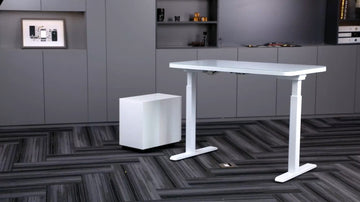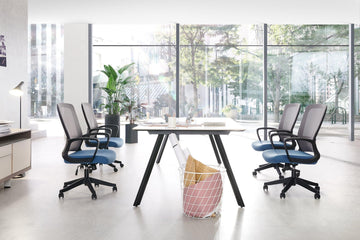Health Benefits of Height-Adjustable Standing Desks

People who spend most of their time sitting have a higher risk of cancer, cardiovascular disease, type II diabetes and premature death.
Of course, a lot of work done in the office today requires people to sit in front of laptops or personal computers and stoop, which is not helpful.
This runs counter to the motion design of the human body, rather than staying in one place and doing monotonous work. Prolonged sitting can affect posture and is harmful to the spine.
Therefore, it is important to consciously integrate exercise into your office work so that you will not be adversely affected by a sedentary lifestyle.
In addition to standing and moving away from the desk at regular intervals, there are some trends in office furniture designed to encourage mobility.
The height adjustable desk is now a popular fixture in modern offices. They can easily transition from sitting to standing.
These occasional changes in body position and posture are essential not only for effective blood circulation, but also for keeping the brain alert.
Here are seven health benefits of a height adjustable desk. After reading this, you will think about how you would have worked without it.
1. Relieve back pain

Back pain and pain are common complaints of office workers. Lower back pain is associated with physical and psychological stress.
Research shows that employees with long-term back pain benefit greatly from standing desks. Another study released by the Centers for Disease Control (CDC) showed that a standing desk can reduce upper back and neck pain by 54% in just four weeks.
Of course, the reverse is also true. Once a standing desk is removed, the benefits from a flexible or height adjustable desk can be reversed within two weeks by returning to sitting for a long time.
2. Height adjustable desk for enhanced comfort

In addition, 87% of those who were asked to use a standing desk said they felt more energetic overall.
On the contrary, when they were asked to return to their original desks, their emotions fell back to their pre study levels.
The results of this study confirm the association between a sedentary lifestyle and a high risk of depression and anxiety.
3. Adjustable desk improves productivity
For those unfamiliar with the use of height adjustable desks, a major problem is that they may have a negative impact on a person's ability to perform daily tasks, such as typing.However, for those who successfully transitioned from full-time sitting to height adjustable desks, there was no significant impact on their ability to perform the same tasks, including typing speed.
In addition, since standing desks can promote users' emotions, it is certain that standing desks will improve work efficiency.
4. Prevent unhealthy weight gain

Sitting burns 60 to 102 calories per hour (depending on your weight, of course), and standing burns about 7 to 10 calories.
The small difference in heat combustion does not seem to be significant. However, if you consider how it accumulates in a week, a month, or a year, the differences may accumulate.
5. Height-adjustable desk reduces risk of cardiovascular disease

This concept was put forward as early as 1953, so it is not new. In a study comparing bus conductors and bus drivers, it was found that the risk of death from heart disease-related diseases of bus conductors was half lower than that of sitting and driving.
It is this study that has stimulated scientific interest in the impact of sitting posture on cardiovascular health.
It is now believed that sitting for a long time increases the risk of heart disease by 147%. The harmful effects of a sedentary lifestyle are so devastating that even an hour of vigorous exercise cannot completely offset them.
They may help lower blood sugar levels
Elevated blood sugar after meals is usually harmful to health. This is especially true if you have type II diabetes.
However, in a study of office workers who stood for three hours after lunch, the increase in blood glucose was 43% lower than when they sat for the same time.
Another study showed that alternating standing and sitting positions every 30 minutes throughout the working day helped reduce peak blood glucose by about 11%.
At the same time, it is known that sitting after meals increases the risk of type II diabetes by 112%.
7. Standing at work can prolong your life

As mentioned earlier, there is a close link between early death, type II diabetes, heart disease and a sedentary lifestyle.
On the contrary, more exercise will not only increase a person's chances of losing weight, but also improve overall health. In fact, a study shows that as long as you reduce the time you spend sitting to three hours a day, the average American life expectancy can be extended by two years.
Although more research is needed to finally determine the causal relationship between more exercise and longer life span, past research and currently available evidence suggest that simply standing more can help improve overall health.
Health Benefits of Height-Adjustable Standing Desks cannot be ignored
Like any form of physical activity, it is not advisable to suddenly change from sitting all day to standing all day.
If you do, you risk pain in your legs, back, neck, or feet. What you need to do is gradually relax yourself, starting from standing for 30 to 60 minutes a day, and then slowly increase.
To make sure you don't stand too much at once, use an alarm clock to remind you when you need to switch from standing to sitting, and vice versa.
You also need to figure out for yourself which tasks you can accomplish more effectively while standing and sitting. In this way, you can use a height adjustable or standing desk to complete daily tasks.
The introduction of height adjustable or standing desks in the workplace should be considered as another way to provide employees with flexible desk seating options.
In addition, in order to benefit employees who use desks, desks need to be adjusted to meet the height and physical requirements of each user.
Users also need to comply with the following provisions to ensure that they benefit from this new manual labor arrangement:
- They must remain upright.
- Ideally, their upper arms should hang vertically downwards.
- There should be a right angle between the upper arm and the lower arm.
- The inclination of the head and eyes should be equal to about 30 to 35 degrees.
Studies have shown that reducing sitting time can reduce the risk of early death and prolong life.
It's time to take a stand
Reducing sedentary time can improve physical, metabolic and even mental health. This is why sitting less and standing more is such an important lifestyle change.
If you plan to start using a standing desk, it is recommended that you spend half the time standing and half the time sitting.


